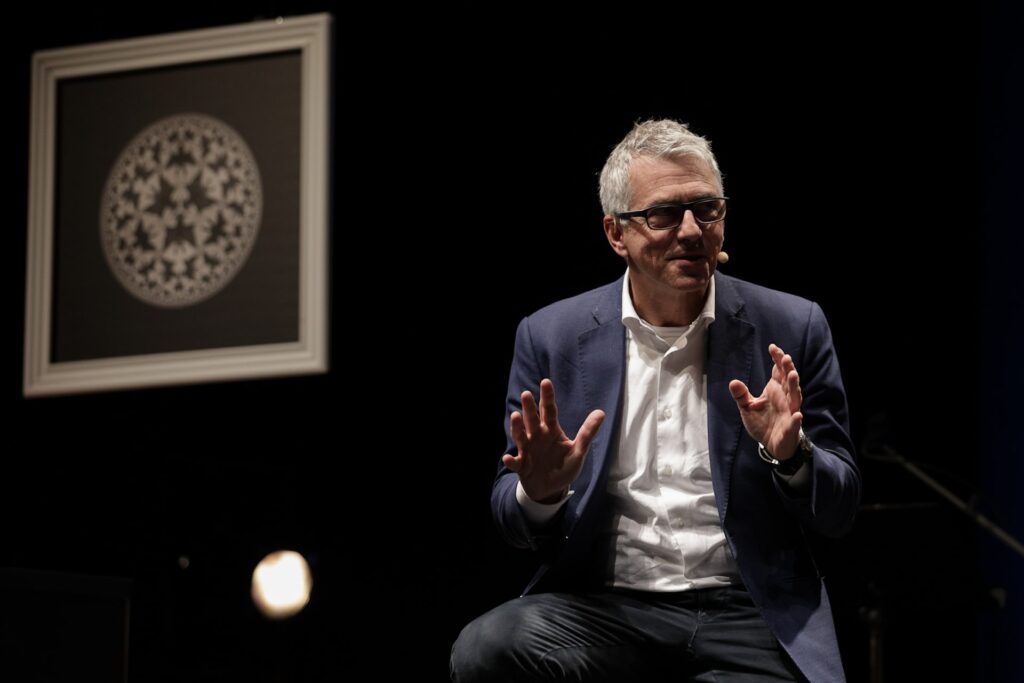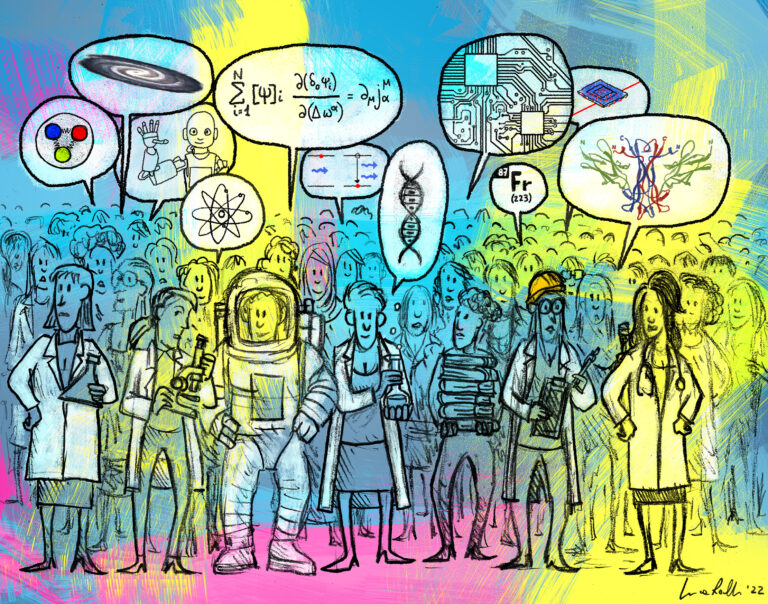Launched at the beginning of July 2021, Collisioni.infn – Spazi culturali all’Istituto Nazionale di Fisica Nucleare (Cultural Spaces at the Italian Institute for Nuclear Physics) is the new INFN web space dedicated to encounters with the public and to the dialogue between physics, other sciences, and all the other expressions of arts and culture. Organised in thematic sections aimed at the public, schools, cultural institutions and other research bodies, Collisioni.infn daily proposes new initiatives for public engagement created and organised by INFN: shows, events, and participation in festivals and exhibition spaces, exhibits and installations, projects dedicated to schools, interactive initiatives devised for social media. Full of links to video and multimedia resources developed for the public by INFN, Collisioni.infn is also a chance for individual learning and keeping up-to-date. Thus, it is particularly useful for students and teachers, as well as for the interested public of any age. An editorial section opens the site, a window that connects the different languages used for developing the projects: initiatives that INFN creates in collaboration with artists and in dialogue with the humanities disciplines and other scientific fields.
We propose here the interview that inaugurates the editorial section of Collisioni.infn, “Incontri” (meetings), dedicated to the dialogue with leaders in the cultural, scientific and intercultural landscape. In the interview, the INFN president Antonio Zoccoli outlines the objectives, values, and expectations connected to this new communication project.
What are the goals of a basic physics research body when it promotes initiatives dedicated to interculturality?
In the current historical moment, whose complexity is sharpened by the pandemic, it’s more important than ever to bring knowledge, not only science, to the centre of social life. It is essential that the centrality of all the sources of knowledge is restored. In this context, the new INFN web space has the objective of offering the public, of any age or education, a knowledge portal dedicated to the dialogue between science and other cultures. As a research community, we have acquired a vast heritage of specialist scientific knowledge, which has, however, implications in many other sectors of the creative and intellectual sphere. From the most immediate, like the technological field, to the more unexpected, like arts, philosophy and humanities.
The hope is that this web space contributes to raising awareness in society: an occasion for entering into contact and getting to know not only scientific research and its methods, but also its interconnections with other spheres of knowledge. In general, I hope that it can contribute to facilitating the access to knowledge. Particular attention will be dedicated to communication with young people. We pursue this goal, first, because the younger generations will shape the future and, secondly, because we hope that our passion for research may breakthrough and that some young people may want to undertake this journey with us.
What meaning do you give to the word “knowledge”?
Knowledge is the result of our curiosity in what surrounds us and is, at the same time, the tool for further investigating the impacts of reality and its complexity. In this sense, knowledge has a profoundly unitary character, although it is divided according to different facets.
The different fields in which we are used to classify knowledge are strongly connected and interdependent. Because of this, over history, the evolution of philosophical thought, of arts, and of science always went hand-in-hand. Separating them is, more than anything else, an artifice due to the fact that we all struggle, some more and some less, to embrace the vastness of knowledge in order to fully grasp its unity. In any case, it’s always worth seeing connections emerge between the different forms of knowing, not only for the pleasure of fuller knowledge, but also because widening our perspective and leaving our own cultural sphere facilitates creativity and ingenuity, including in one’s own field.
What prevents sharing knowledge with the public today?
Contemporary ways of living have their roots in scientific and technological knowledge. The wellbeing that we enjoy is owed, above all, to the achievements of science in all fields and to developments in technologies that have radically changed our habits and continue to do so at increasing speed. Despite this, many people tend to distrust science, and even technology, although they depend on it. It is a paradox. One way to counteract this tension with regards to antiscientific thought is to ensure that the positive impacts of pursuing science return to the fore. These include the social benefits of the achievements of science, but also the efficacy of the scientific approach for interpreting the reality in which we live and the way in which we relate to it.
A good relationship with science, its method and its language is the first step towards the freedom that follows from knowing how to make informed choices.
What is the role of scientists in public science communication?
As an expert in the research profession and its topics, the scientist is the most suitable and most authoritative person for establishing a direct dialogue with the public on scientific issues. I don’t want to dismiss the essential role of mediators, science communicators and those who popularise the subject, professionals in the planning of tools, in the innovation of language and dialogue with the media. However, scientists are always the most credible direct narrators: they have a profound knowledge of the content and can convey, as direct experience, the passion that they experience in doing the research in which they’re a major players. This doesn’t mean that every scientist is necessarily able to establish a communication channel with the public or that it doesn’t require a certain amount of work. We must develop the right, simple, concise language, in compliance with the rigour that science requires, but we must also know how to convey emotions and passion for doing research.
The scientific community counts charismatic scientists among us, able to communicate by nature, and others who will probably have to make some extra effort. Some, unfortunately, erroneously believe that the task of the scientist is exclusively that of doing research and that communicating their work and its results is a waste of time. On the contrary, communicating is an indispensable mission, a duty in relation to society. Without considering the personal benefit. Finding the way to describe something complex, as many ideas in physics are, always enables you to see your own knowledge from a different perspective and to grasp aspects of it that you would have perhaps never seen.
If you had to express a wish, even an ambitious one, to entrust to this online space and to other science communication initiatives what would it be?
That, in the near future, children look at the scientist with the same admiration that they nurture for soccer players, singers, or actors. The scientific community, institutions, and schools, as well as families, must reflect on the fact that most children’s ambitions in science aren’t comparable with their ambitions in soccer or the entertainment business.
The package of values that we adults transmit, in the different ways, is certainly responsible. We should stimulate scientific curiosity and the desire to learn through research. Although it’s difficult, scientific training almost always guarantees a long-lasting and dynamic career, and not just in research. If this idea isn’t shared by young people, the responsibility probably resides in the way in which we talk about science to children, at school and in the family, and in the lack of a dedicated and effective TV offering, as well as on new media and online.
From 1 June, you assumed the role of President of the Council of Presidents of Public Research Bodies. What role can the council have in the challenge for reviving the value of knowledge?
The Council of Presidents of Public Research Bodies [CONPER – ed.] has a strategic role, at the national level. It has the task of supporting the government in promoting, supporting, and relaunching activities in the research sector and of formulating proposals for drafting, implementing, and updating the National Research Programme. The responsibility of this role is even more urgently felt now that we have a very significant challenge in front of us. At a strategic level, the National Recovery and Resilience Plan is a unique opportunity for the relaunch of our country and research, which must do its part, with commitment and seriousness, creating synergies for ensuring that the resources that will be invested produce the best results.
The Presidents of the public research bodies have, on the other hand, a very important responsibility, including at a cultural level. The chance to establish increasing public awareness with regards to science is in their hands and in that of the institutions that they represent, as well as in the hands of schools and universities. In general, the value collectively attributed to culture and to scientific thought is the responsibility of those who design and implement the strategies for scientific research, in all fields of science.
“Incontri” (Encounters) is a regular editorial of Collisioni.infn, dedicated to dialogue with the witnesses of the intercultural exchange between the scientific community, in particular the INFN, and the cultural world as a whole.



